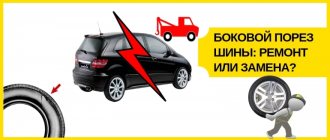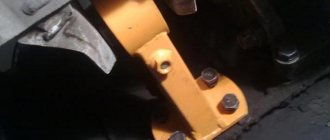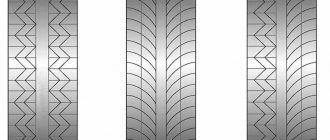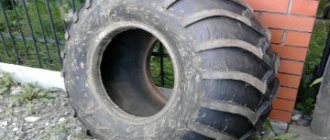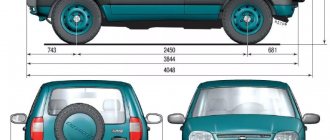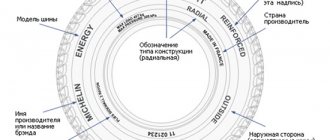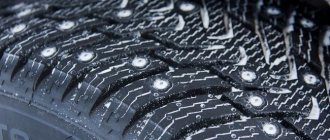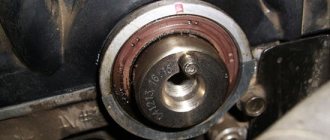Any tire fitter will tell you that not every tire defect can be repaired. Sometimes the damage is so significant that further operation is impossible. Then the question arises of what to choose: repair or replacement of a tubeless tire with a side cut and a puncture in the tire. The solution largely depends on the skill of the technician, the size and location of the problem, and how you plan to use the vehicle. If you need to hold out for several weeks before a scheduled replacement, then the patch will probably hold out.
In the article we will tell you whether the service will always undertake to repair the damage, whether it is worth driving on such tires and why it is dangerous. You will also learn how to fix the problem on your own and what tools you will need to do this.
Is it possible to repair a side cut on a tire and how to seal it
It is possible to repair a wheel with a hole in the side, but this solution is not always advisable. Not every tire shop will take on such work, because, firstly, it requires a lot of experience and skill, and secondly, it is very difficult to complete the task efficiently even for a professional.
Why does this problem occur? Potholes, stones and other sharp objects on the roads are the main causes of punctures, most often they occur on the tread. Repairers are good at repairing such damage, but the situation with side cuts is much more difficult. If such a defect occurs, the car cannot be used for a long time; urgent replacement or competent assistance is required.
Universal patches
They are a vulcanized product equipped with a polymer backing. Such tire patches can have a round, square, oval, or hexagonal shape. With their help you can eliminate:
- small punctures;
- cuts;
- ruptures.
The main condition for their use is maintaining the integrity of the cord.
To install such a product, special glue and cold vulcanization method are used. The multi-layer construction of the material makes it durable and flexible for operation under variable load conditions.
Consumables of this type can be used not only by private vehicle owners, but also by tire shops. The popularity of universal patches is associated with some of their obvious advantages:
- simple repair technology;
- there is no need to use hot vulcanization;
- contribute to the creation of a rigid frame inside;
- have sufficient thickness and elasticity;
- differ in a variety of shapes and configurations;
- characterized by low cost.
They can be used to repair minor damage, cuts, punctures, in which there is no damage to the cord threads.
How does a tire work?
Before you begin to solve the problem yourself, you need to understand what you are dealing with. Repair work will vary significantly depending on the location of the puncture, as well as the type of tire.
The tire has a complex structure. The main load is borne by the stiffeners. These are two frames, each of which helps to correctly distribute the load on the entire wheel:
- Metal - created from the thinnest wire.
- The frame is made of nylon threads - a synthetic material, distinguished by its strength and lightness; it contains petroleum products.
If you cut a tire crosswise, then in cross-section it will form the letter “C”, which consists of numerous layers. The layer-by-layer structure contributes to wear resistance, strength, and improved traction.
Main elements of a tire:
- Cord frame (cord) is a skeleton that consists of interlacing metal threads with synthetic ones. Most often nylon is used, but sometimes it is cotton or viscose.
- Breaker. There is an additional rigid layer on top of the cord, but it is located only on the working surface and is intended to protect against punctures. The absence of a breaker should be taken into account when repairing side damage to a tire.
- Tread. This is a thick layer of rubber that is located on the outside. It is designed for direct contact with the road surface. The pattern helps improve traction and control movement in the rain. As long as the tread wears gradually and evenly, the cord is protected and the basic functions of the wheel remain normal.
The internal structure of the cord frame is of two types - radial and diagonal, depending on how the threads are arranged among themselves. The first option is preferable from a reliability point of view, so this type is now predominantly produced. The technology involves placing metal wire and nylon parallel to each other, without crossing diagonally, as in the second option.
When repairing a tire, it is also important to know its external structure:
- Boards. This is the outermost section of the tire; they are responsible for its secure fit to the disc. The material here is quite strong due to the additional power rings made of metal wire, so it is very difficult to damage them naturally.
- Sidewalls. Their damage is most undesirable and rare, usually also due to deliberate intent. This is the most voluminous element of the wheel in terms of space occupied. The additional layer of rubber just protects the cord.
- Shoulders - smooth transition to the tread. They are involved during movement, when turns are made, and also when hitting bumps. In this case, punctures occur regularly, and repairmen are well aware of how to repair the side cut on the shoulder of the tire.
- Treadmill. This fragment is constantly in contact with the road, so the largest number of layers is used to create it. This is where most of the damage occurs.
Our production
Why is a tire cut dangerous?
It all depends on its depth. As a rule, if a sharp object penetrates deep enough, the cord layer is damaged. Thin metal wires, as well as nylon cord threads, break, which violates not only the strength of the zone, but also the overall geometry. As a result, even after installing the patch, the reliability of the wheel is questionable; it can explode under excessive loads and even just while driving. The fact is that a torn frame cannot be put back together in any way, and the repair will consist only of the outer layer. Glued rubber cannot always withstand significant internal pressure in combination with external mechanical influences.
Whether you can drive with a tire cut on the side is up to you to decide. But remember that in such a situation there is a high probability of a sudden break. If this happens at high speed, a skid with the possibility of an accident is guaranteed.
Professional restoration
How are tire side cuts repaired in special auto repair shops? Tires repaired at auto repair shops last longer than tires sealed at home. A good result of repair work carried out by specialists is determined by the following factors:
- availability of special equipment, tools, high-quality consumables;
- special education and experience of masters.
In equipped workshops, the process of eliminating cuts on the side surface of tires consists of the following steps:
- The tire is dismantled and the dimensions of the slot are measured.
- The edges of the cut are trimmed to ensure quality boiling.
- Using a special drill, the surface requiring repair is cleaned.
- A special cementing agent is applied.
- Raw rubber is being cut. Thin rubber strips are placed in the slot previously prepared for gluing.
- The tire is vulcanized in a special chamber.
- After vulcanization, the damaged area is cleaned and markings are applied to install a reinforced patch.
- The prepared area can be degreased, then a special cementing agent is applied and after it dries, the patch is glued.
- The edges of the glued patch are treated with sealant.
- After the sealant has hardened, the tire is mounted on the wheel and balanced.
Please note: a repaired tire must undergo a run-in, during which you cannot drive at high speeds or use an aggressive driving style, or put a lot of load on the wheels.
What types are there
They are divided into:
- horizontal;
- diagonal;
- vertical.
In some cases it can be doubled in the form of a diverging triangle. Vertical and diagonal types are considered beyond repair.
It is also worth paying attention to how the rubber is cut relative to the cord threads. If along them and the strength of the hull is not significantly compromised, the situation can really be corrected. When they are cut across, the gap is almost impossible to repair. To determine this, you need to know what type of tire you have - radial or diagonal.
In order to understand whether repair is possible, count the number of damaged threads. For example, for trucks there is a rule: if more than 10 pieces are torn, welding the cut on the side of the tire or patching it in any other way is prohibited. In this case, the rubber is sent for disposal, since it is dangerous to use.
Criteria for suitability for repair
Some car enthusiasts, at their own peril and risk, deliberately allow patches for holes 3 and 5 cm in length (with a longitudinal and perpendicular location to the cord threads, respectively). To decide whether to contact a service center or do the work yourself, rely on the type of tire you have.
Radial
The cord threads are located perpendicular to the circle - in this direction the entire structure is most reliable and stable on the roads. They are not intertwined, but are parallel to each other.
The disadvantage of such tires is that after any repair, their quality cannot be restored to their original parameters. So yes, it is possible to repair radial tires with a side cut, but it will only help for a short time, and you will still have to change the tires soon.
Diagonal
In terms of maintainability, this is a better option. If one section is damaged, the overall reliability of the structure remains at a high level due to the strong weave of the threads. Since the load during movement will be distributed evenly, both rigidity and geometry will remain at the same level. In this case, there is only one problem - diagonal cord construction is becoming less and less common.
There are other criteria. For example, a chamber inside the rubber increases the permissible gap value by another centimeter. Be sure to check its integrity - torn thin metal wires can touch and puncture the rubber layer.
With freight transport, the main criterion for repairability is the number of broken threads. If there are more than 10 of them, then the tire is considered unsuitable for further use.
What's the result?
When a cut appears, the first thing you need to figure out is what is more rational: buy a new or used tire or repair the cut. You should be guided by the size of the damage, the age of the tire and the cost of both the tire and resuscitation tire services. Despite the level of development of repair technologies, it is worth experimenting with eliminating large side cuts in special cases, such as slow tire size, high price, etc.
And remember, if you have a repaired tire in your hands, it is better to install it on the rear axle, or even better, in place of the spare tire.
Source
Is it possible to repair a side cut on a tire and how to do it: technique
Of course, it is possible to fix the problem. But we note that a cut located in the assembly is very difficult to repair. What technologies are used for repairs?
The most commonly used is a special patch. This is a patch that is made of pressed rubber - it is virtually poreless, so it does not allow air to pass through, and also contains cord materials to ensure rigidity. These threads are needed to keep the breakdown from spreading.
The hot vulcanization method using such a patch is carried out in several stages:
- Inspecting the damaged area, we decide whether it is worth repairing the side cut of the tire and how best to repair the puncture.
- Clean the area (1–1.5 cm from the edges of the hole) using a sander. Processing is carried out on both sides.
- Sanding and smoothing the edges to ensure better adhesion to the repair compound.
- Apply a layer of glue, let it dry, sand again.
- Attaching the patch to the inside of the tire, this ensures the release of air that collects in it. To do this, use a roller and movements from the center to the edges.
- Measuring the depth of the cut.
- Applying hot glue - it should dry in 15-20 minutes.
- The grooves are filled with pieces of rubber, and the top is rolled out with a roller.
- Fastening on a special device - a vulcanizer.
- Curing. The duration of the stage depends on the thickness of the rubber layer. On average, you have to spend 4 minutes per 1 mm with a classic temperature regime (100-120 degrees).
- Decorative polishing.
Tools for repairing tires with a side cut or puncture on a wheel: how to seal a tire
If you want to solve the problem yourself, and this can be done with a minor malfunction, you will need:
- strips of raw material;
- sanding machine or regular sandpaper;
- source of high temperatures - for example, a hair dryer;
- degreasing liquid;
- purchased patch reinforced with cord threads.
We do the repairs ourselves
- Sand the edges of the cut with sandpaper.
- Degrease the work area.
- We fill the holes with rubber and heat it with a hair dryer.
- We clean it using a grinding machine.
- Attaching the patch.
- We balance the wheel.
Popular goods
Repairing a small wheel cut on the side of a tire at a service station
The same algorithm will be used here, but with the use of more complex techniques and equipment. For example, the edges are processed using side cutters, and the rubber is heated with a special vulcanizer, and not with a hairdryer. In addition, the materials themselves will be of higher quality. You won't have to worry about this kind of work.
Basic information about trailer support wheels
- in the place of damage, the edges must be ground off;
- the damaged area should be shaped into a bowl or saucer;
- raw rubber is placed into the resulting cavity;
- then the vulcanization process begins;
- for self-vulcanization you will need a hair dryer;
- then a durable patch is laid;
- the outside of the restored wheel is cleaned;
- the balancing procedure is carried out.
The main problem in DIY repairs is hot vulcanization. Car service centers usually use special cameras. Garage-type service stations also use a hairdryer, which is not the best solution compared to a special camera.
